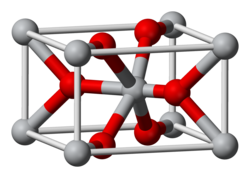Top Qs
Timeline
Chat
Perspective
Iron(II) fluoride
Chemical compound From Wikipedia, the free encyclopedia
Remove ads
Iron(II) fluoride or ferrous fluoride is an inorganic compound with the molecular formula FeF2. It forms a tetrahydrate FeF2·4H2O that is often referred to by the same names. The anhydrous and hydrated forms are white crystalline solids.[1][5]
Remove ads
Structure and bonding
Anhydrous FeF2 adopts the TiO2 rutile structure. As such, the iron cations are octahedral and fluoride anions are trigonal planar.[6][7]
The tetrahydrate can exist in two structures, or polymorphs. One form is rhombohedral and the other is hexagonal, the former having a disorder.[1]
Like most fluoride compounds, the anhydrous and hydrated forms of iron(II) fluoride feature high spin metal center. Low temperature neutron diffraction studies show that the FeF2 is antiferromagnetic.[8] Heat capacity measurements reveal an event at 78.3 K corresponding to ordering of antiferromagnetic state.[9]
Remove ads
Selected physical properties
FeF2 sublimes between 958 and 1178 K. Using Torsion and Knudsen methods, the heat of sublimation was experimentally determined and averaged to be 271 ± 2 kJ mole−1.[10]
The following reaction is proposed in order to calculate the atomization energy for Fe+:[11]
- FeF2 + e → Fe+ + F2 (or 2F) + 2e
Synthesis and reactions
The anhydrous salt can be prepared by reaction of ferrous chloride with anhydrous hydrogen fluoride.[12] It is slightly soluble in water (with solubility product Ksp = 2.36×10−6 at 25 °C)[13] as well as dilute hydrofluoric acid, giving a pale green solution.[1] It is insoluble in organic solvents.[5]
The tetrahydrate can be prepared by dissolving iron in warm hydrated hydrofluoric acid and precipitating the result by addition of ethanol.[1] It oxidizes in moist air to give, inter alia, a hydrate of iron(III) fluoride, (FeF3)2·9H2O.[1]
Uses
Battery research
FeF2 has been investigated as a cathode material for both lithium-ion and fluoride-ion batteries. Unlike conventional metal oxides, which rely on an intercalation-based lithium storage mechanism, FeFX (x = 2, 3) operates via a complex conversion mechanism, resulting in higher energy density. Fluoride cathodes are stable up to 1000°C.[15] Stability not only enhances safety and lowers the risk of thermal runaway.[16]
FeFX exhibits distinctive phase evolution, intermediate phases, and morphological transformations during lithiation and delithiation.[17][18] A stable lattice of fluoride anions is maintained throughout charge and discharge cycles, consistent with high cycling reversibility.[19][20]
Remove ads
References
External links
Wikiwand - on
Seamless Wikipedia browsing. On steroids.
Remove ads





